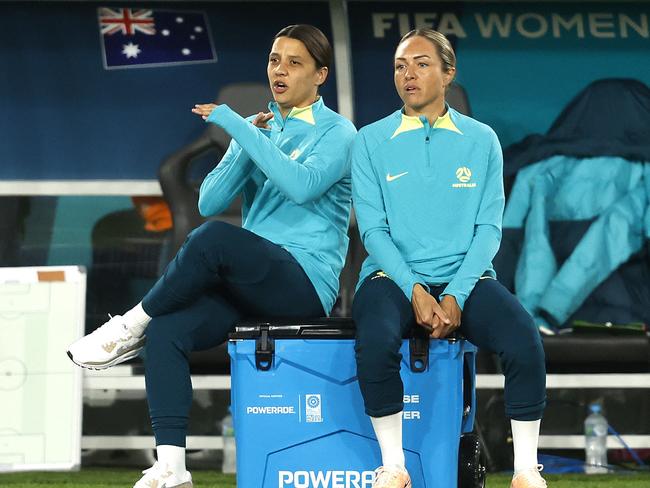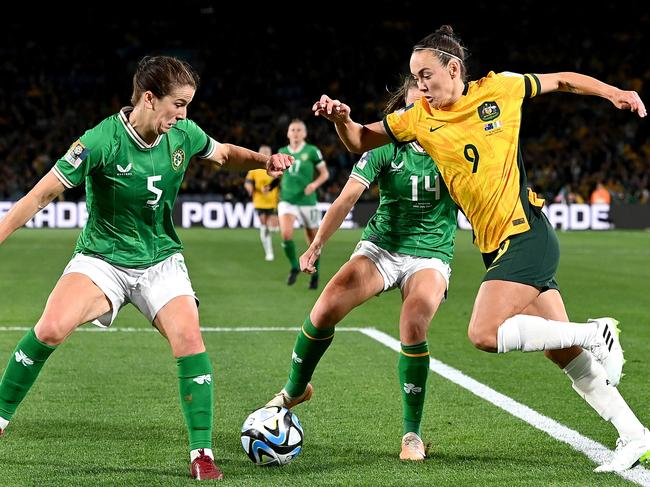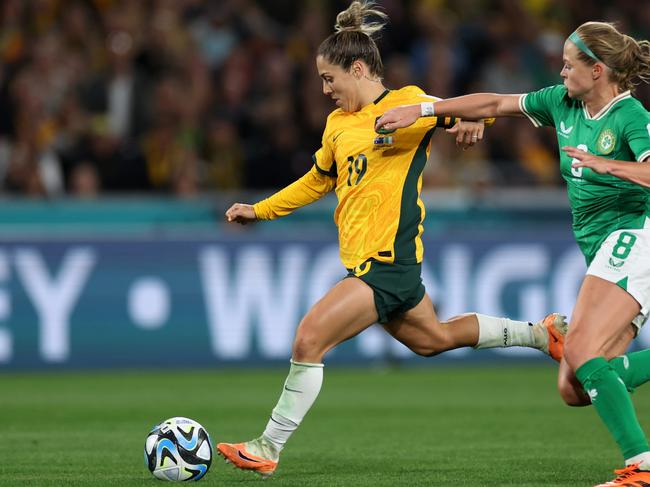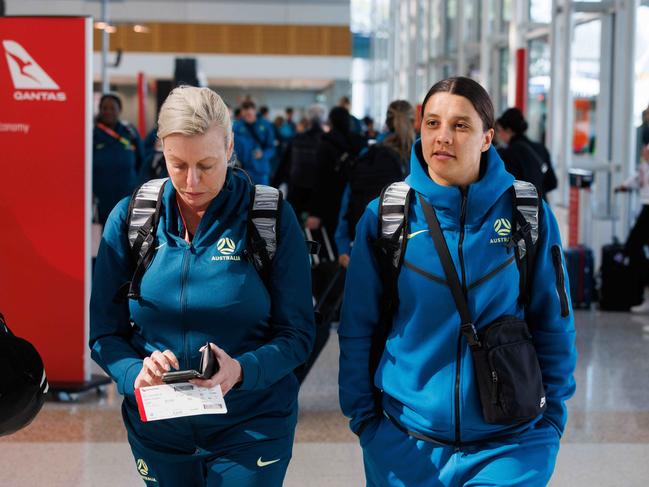FIFA Women’s World Cup 2023: Matildas face strategic overhaul, difficult decisions after Sam Kerr injury
Can the Matildas still win the 2023 World Cup without Sam Kerr? ADAM PEACOCK breaks down the strategic challenges.

Football
Don't miss out on the headlines from Football. Followed categories will be added to My News.
Tony Gustavsson proved he can keep a secret.
Now to solve a mystery.
Thursday’s World Cup opener against Ireland marked just the fourth time in the Gustavsson era that Sam Kerr has been absent from a Matildas line-up dating back to 2021.
The anxious 1-0 victory over Ireland was the first of those matches to result in a win. It wasn’t perfect and, given the turbulence of the final 24 hours before the game, it was never going to be.
Kerr’s future at this World Cup is unknown. Calf injuries can be notoriously fickle and slow to heal. So while she receives every conceivable method of treatment in the hope of returning for a late tournament surge, Gustavsson must find inspiration from his remaining attacking parts for the next match against Nigeria – and possibly beyond.

Kyah conundrum
The 1-0 win against the gallant Irish was well short of fluid and Kerr’s absence evidently placed more pressure on the Matildas’ already depleted attacking depth.
Kyah Simon didn’t warm up with the main group on Thursday. As much as her guile would be welcome in chaotic endings, such as the Ireland game, it’s unreasonable to expect her to play anything more than a handful of minutes off the bench given that she has not played a game at any level since injuring her ACL last October.
Coupled with Kerr’s absence, the selection of the recovering Simon places strain on the endurance capabilities of wingers Cortnee Vine and Hayley Raso, both of whom will be forced to play bigger minutes.
There are ways around it, though, and it all starts with feeding the two most creative players on the pitch who were starved on Thursday.
Unlocking Foord
Caitlin Foord and Mary Fowler had supplies cleverly cut by the Irish, a perception emphasised by startling numbers.
Fowler had just 13 touches in the attacking third while Foord fared slightly better with 17. Magic can’t manifest with such low numbers.
To truly illustrate how congested the middle was, Steph Catley, in a wider area from left back, had 18. And to provide further context, Kerr had an average of 28 touches in the final third at the 2019 World Cup.

It wasn’t Foord and Fowler’s fault that they combined for just 30 touches in Ireland’s final third. The Irish had three centre backs who barely left each other’s side and, in front, two defensive midfielders who screened every movement Fowler made.
Foord only got on the ball with clear air when she drifted into wide areas, swapping occasionally with Vine who moved centrally. Two dangerous moments in the first half ended in corners to Australia when Foord got one-on-one with an opposing fullback.
Fowler is the one, though, who was truly famished when it came to possession. Playing more of an attacking midfielder role, Fowler got into great areas but couldn’t be found by teammates either unable to spot her, or unwilling to trust themselves to zip a pass through a narrow corridor.
Fowler is the type of player who doesn’t mind receiving under immense pressure. The 20 year-old would find space on a peak hour train, evident in one little sprinkling of magic in the first half when she spun 360 degrees to get away from close attention into open territory.

Gorry factor
Somewhat overlooked in an anxious victory was the performance of Katrina Gorry, which surprised precisely no one who has paid close attention to the Matildas since the midfielder made her return to the national team after giving birth in April of last year.
In patient build up play, it was obvious Gorry’s instruction against Ireland was to play to wide areas and avoid the heavy traffic through the middle.
Gustavsson and his coaching staff won’t need to dig too deep into Friday’s clash between Nigeria and Canada to tweak the next set of instructions.
Nigeria, whom the Matildas meet in Brisbane next Thursday, aren’t as rigid as the Irish without the ball. Rarely does their midfield bank set themselves with the discipline Ireland did. Fowler and Foord will thrive if delivered the ball quickly.
The game might also be the perfect opportunity to use Alex Chidiac, a prototypical playmaking attacking midfielder, late in the game against a tiring opponent.
The Nigerian fullbacks like to get forward, too, which will mean more space for Vine and Raso to burn into as transitional moments pop up.
Canada, the last group game on Monday week, will present a mesh of what both Nigeria and Ireland provide.
The Olympic champions looked a little clunky on Friday against Nigeria, but they are difficult to break down with their athleticism quickly getting numbers behind the ball.

Hopping Kerr
Kerr is apparently targeting the Canada game on July 31, which seems a quick recovery from a calf injury she was loath to put under any kind of pressure on Thursday, hopping in celebration to Catley’s penalty.
There is now a new most famous calf in Australian sport, usurping Nathan Lyon’s. But while he defied medical advice to bat against England at Lord’s on one leg, he also knew his tour was over and didn’t care about more damage.
Kerr has no such luxury.
She only gets one chance at taking a risk.
Before then, the Matildas need to take a few more to stay in control.
Originally published as FIFA Women’s World Cup 2023: Matildas face strategic overhaul, difficult decisions after Sam Kerr injury



